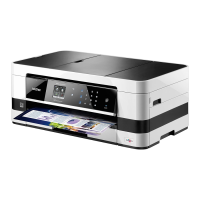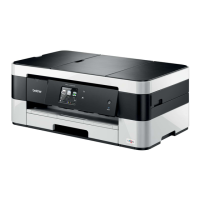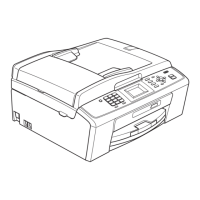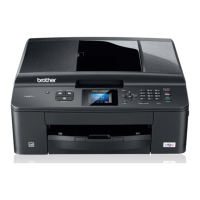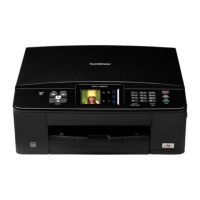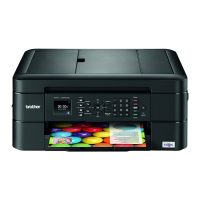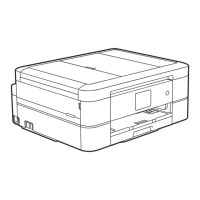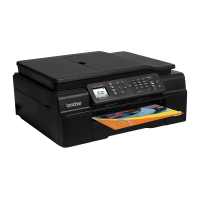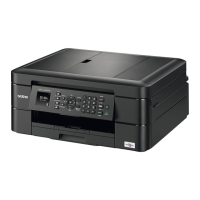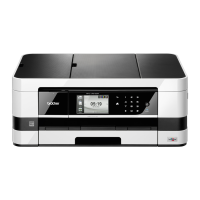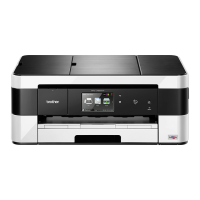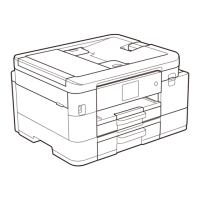Do you have a question about the Brother MFC-J4440DW and is the answer not in the manual?
Explains the symbols and conventions used throughout the guide for clarity and safety.
Lists registered trademarks and mentions other company trademarks used in the manual.
States the product includes open-source software and provides a URL for licensing information.
Displays copyright information for Brother Industries and software vendors used in the product.
Provides crucial advisories on software updates, product usage, potential regulations, and model naming conventions.
Covers pre-operation checks, paper selection for quality, and simultaneous printing/faxing capabilities.
Details the buttons and features of the machine's control panel, including mode and settings buttons.
Explains the Home screen icons and indicators for Quiet Mode, Wireless Status, Ink, Date/Time, Faxes, and Receive Mode.
Describes the touchscreen interface, including Date & Time, Quiet Mode, Shortcuts, Modes, Information icon, and Warning icon.
Details the functions accessible via the touchscreen's Settings menu, such as Maintenance, Receive Mode, Date & Time, and Network.
Provides instructions on using fingers to interact with the LCD touchscreen to access machine options.
Explains how to change the machine's Ready screen to different options like Screen 1, 2, 3, or Shortcuts.
Guides users on how to set the default Scan screen using the Screen Settings.
Explains how to input text using the dial pad or touchscreen keyboard for settings like Station ID.
Describes how to launch Brother Utilities, an application launcher for accessing Brother applications installed on a computer.
Shows where to locate the USB and Ethernet ports inside the machine for connectivity.
Covers instructions for loading paper into Paper Tray #1, Paper Tray #2, and the Manual Feed Slot.
Details how to load documents into the Automatic Document Feeder (ADF) or onto the Scanner Glass.
Guides users on various printing tasks from a Windows computer, including photo and document printing.
Provides instructions for printing from a Mac computer, specifically mentioning AirPrint.
Explains how to print photos or documents using the Brother iPrint&Scan application.
Details the process of printing photos directly from a USB flash drive without a computer.
Describes how to print files by emailing them to the Brother machine.
Explains how to scan documents using the Brother iPrint&Scan application on Windows and Mac.
Details various methods to scan photos and documents from a computer using Windows applications.
Describes how to scan documents from a Mac computer, specifically mentioning AirPrint.
Guides users on configuring scan settings remotely via Web Based Management for enhanced control.
Provides step-by-step instructions for making copies of documents using the machine's control panel.
Explains how to resize copied images by selecting an enlargement or reduction ratio.
Details how to sort multiple copies so they are stacked in the order they are fed.
Describes how to save paper by copying multiple pages onto one or creating poster-like prints.
Guides on reducing paper usage by copying documents onto both sides of the paper.
Explains how to copy both sides of an identification card onto a single page.
Details various copy settings such as Quality, Paper Type, Paper Size, and Density.
Explains how to configure the machine to receive faxes, including mode settings and detection.
Details features related to voice calls, storing numbers, and setting up broadcasting groups.
Discusses connecting external devices and configuring telephone line settings like Caller ID and PBX.
Covers settings for transmission verification reports and fax journals.
Explains how to send and receive faxes using a computer via PC-FAX software.
Outlines the network features supported by the print server across different operating systems.
Guides users on configuring network settings either via the control panel or Web Based Management.
Details how to set up and use wireless network connections, including Wi-Fi Direct.
Covers features like printing network reports, LDAP search, time synchronization, and network reset.
Introduces Brother's management tools for configuring network settings and downloading software.
Provides an overview of network security features and recommendations for disabling insecure protocols.
Explains how to configure certificates for secure SSL/TLS communication and device authentication.
Details how to use SSL/TLS for secure communication, including managing network machines and printing documents.
Guides on securely managing the network machine using SNMPv3 for user authentication and data encryption.
Explains how to configure IPsec for secure data transmission, including address and template settings.
Describes IEEE 802.1x authentication for controlling network access and its various methods.
Explains how Active Directory Authentication restricts machine usage and stores incoming fax data.
Details how LDAP authentication restricts machine access and stores incoming fax data for user verification.
Describes how to enhance security by restricting functions and setting user page limits.
Covers configuring secured email sending with user authentication or SSL/TLS.
Explains how to use the Access Lock feature to prevent unauthorized access to machine settings.
Explains how to access online services to upload, view, scan, and print images/files via the Brother machine.
Describes AirPrint as a solution for wireless printing from Apple devices without installing drivers.
Introduces Mopria services for printing and scanning with Android devices without additional setup.
Explains how to use Brother Mobile Connect to print and scan from Android, iOS, or iPadOS devices.
Details how to print data from NFC-enabled Android devices by touching them to the machine's control panel.
Provides an overview of the Brother iPrint&Scan application for printing and scanning from computers.
Lists common error and maintenance messages, their causes, and recommended actions for resolution.
Provides guidance on clearing document jams from the ADF unit and removing paper scraps.
Instructs on locating and removing jammed paper from various areas of the machine.
Offers general troubleshooting advice and directs users to contact support for complex issues.
Addresses common issues related to telephone line connections, incoming calls, and fax transmission.
Helps diagnose and resolve issues related to network connectivity, IP addresses, and wireless setup.
Covers various copying, scanning, direct photo printing, and software-related difficulties.
Provides troubleshooting steps for issues encountered when using AirPrint for printing.
Guides users on how to replace the ink cartridges correctly, including important precautions.
Details the procedures for cleaning various parts of the machine, including the scanner and print head.
Covers checks for print quality, alignment, ink volume, and machine status via computer or application.
Provides steps to adjust paper feed settings to reduce vertical lines in printouts.
Explains how to adjust print settings like Reduce Smudging and Enhance Print for better output.
Gives instructions on how to properly pack and ship the machine, emphasizing print head parking.
Guides on customizing machine settings directly through the control panel interface.
Details how to manage machine settings remotely via a web browser using Web Based Management.
Explains which settings are retained and which are lost during power interruptions.
Covers fundamental machine settings like volume, sleep mode, date/time, and display adjustments.
Allows users to save frequently used settings as shortcuts for quicker access.
Details how to print various reports like Transmission Verify, Address Book, and Network Configuration.
Provides tables summarizing menu selections and options available on the machine's control panel.
Introduces Web Based Management as a utility for managing the machine via a web browser.
Guides on how to access the machine's settings through a web browser using HTTP or HTTPS.
Explains how to change the default password to protect machine settings from unauthorized access.
Details how to manage the machine's address book entries using Web Based Management.
Provides detailed technical specifications for the machine, including printer, fax, and scanner capabilities.
Lists the specifications for replacement ink cartridges and their expected page yields.
Discusses the quality, environmental benefits, and production process of recycled paper.
Offers information on how to get help, download software, and find local support contacts.
| Print Technology | Inkjet |
|---|---|
| Automatic Duplex Printing | Yes |
| Max Scan Resolution | 1200 x 2400 dpi |
| Fax Capability | Yes |
| Display | 2.7" Color Touchscreen |
| ADF Capacity | 20 sheets |
| Functions | Print, Copy, Scan, Fax |
| Mobile Printing | Yes |
| Print Speed (Black) | 20 ppm |
| Print Speed (Color) | 19 ppm |
| Scanner Type | Flatbed & ADF |
| Connectivity | USB, Ethernet, Wi-Fi |
| Ink Cartridges | Black, Cyan, Magenta, Yellow |
| Max Print Resolution | Up to 4800 x 1200 dpi |
| Paper Input Capacity | 250 sheets |
